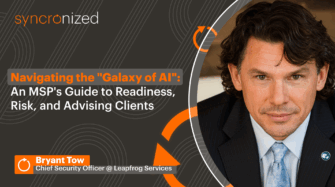Cash flow is like oxygen to your business. If it runs out, you’re in trouble. And the stress of poor cash flow is, in the words of eNerds CEO Jamie Warner, “just brutal.”
Following the global financial crisis in 2008, Jamie discovered a massive problem in his MSP—monthly service bills were not being paid on time. Until then, a regular stream of cash from infrastructure projects was covering the issue. But with a financial crisis in full swing, projects were drying up, and the unreliable trickle of cash flow from services became an obstacle.
Jamie knew something needed to change. “I wanted to have control and consistency,” he said.
His solution? Switching all his clients to direct debit. Today, 100% of eNerds revenue is billed through direct debit and the change to the business was dramatic: “It took away all the stress. I really cannot say that enough,” says Jamie.
Let’s take a look at how and why offering direct debit as a payment method proved so beneficial to eNerds, and how it could help with improving your cash flow too.
What is direct debit?
A direct debit, also known as an ACH transfer, involves transferring money directly between bank accounts.
In the case of your MSP, your clients authorize you to take money directly out of their bank account for your invoice each month, and those funds get sent directly to your bank account.
The advantages of taking direct debit payments
Direct debit is fast, convenient, and efficient for both you and your customers.
- Customers don’t have to remember to make a payment each month, which means they’re never at risk for penalties. They always know exactly when the funds will come out. This can help reduce customer churn and improve customer satisfaction.
- You never have to send out late payment notices, chase customers for payment, or calculate penalty fees, saving you admin time and hassle. Chasing customers is “exhausting,” says Jamie, and “takes away a little bit of the shine of what you’re supposed to be doing as a business.”
- Direct payments are less likely to fail, since bank account details—unlike credit cards—rarely change or expire.
- You have direct access to your money.
- You can use direct debit as a way to give clients short-term credit on hardware purchases, which helps them buy more from you. For example, if you debit clients on the 15th of each month, tell them to order their gear at the start of the month. Rather than needing to pay upfront, they get 14 days grace until their payment comes out.
How direct debit improves your MSP cash flow
Effectively managing the cash flow in your business comes down to timing revenue inflows with expense outflows.
Your business has a lot of outflows that typically happen at the same time each month, and these can’t be easily negotiated or moved. Such outflows include wages, rent, credit card bills, and software subscriptions.
Direct debit gives you a corresponding schedule of reliable inflows. You know exactly how much you’ll receive on what days of the month to ensure you always have enough to cover your expenses.
On the other hand, if you don’t have a reliable schedule of payments coming in, you could feel the cash pinch. “If you don’t do direct debit, [growing] will be a continual nightmare, and the pain will just get bigger and bigger,” says Jamie.
He points out that more and more MSP vendors, like Pax8, are moving to ACH payments as well. “If you’re paying direct debit and you’re getting dribs and drabs of money in, it just does not make sense cash flow-wise—at all.”
How to time your direct payments
When Jamie first got started with taking direct debit payments, his bank recommended he invoice clients mid-month, then take the payment at the end of the month.
“So if it’s April, we invoice on the 15th of April and direct debit on the 28th. Essentially in arrears,” he says.
If he had to do it over again, he’d set himself up to bill in advance: invoice in the middle of April for May, and take May’s payment at the first of month.
But he says that while billing in arrears isn’t quite as “awesome” for cash flow, it can be turned into a good selling point if you emphasize to clients how they’re getting a whole 30 days before they’re debited.
The advantages of direct debit over credit card payments
Could you achieve the same cash flow benefits of direct debit by taking pre-scheduled credit card payments?
Some of the benefits of direct debit and credit card are definitely the same: You know exactly what payments you’re getting when, clients don’t have to think about making payment, and there’s very little admin overhead.
But there are a few places where direct debit wins over credit cards that are worth considering.
- Processing fees for direct debit are usually much lower. On a credit card transaction, you might pay 2-3% of the total in processing fees. Depending on your jurisdiction, you may not be allowed to recoup those fees from your client. That can definitely eat into both your cash and your profit margins.
- Credit card payments more frequently fail. Reasons for declined payments include the card being expired, the number no longer being valid, the limit being reached, or suspicious activity blocking all transactions. Most B2B customers will see decline rates of 5 – 14%, according to Recurly, which will put you back to following up with clients on the missed payment.
How to get your MSP customers switched to direct debit
In 2009, Jamie faced the daunting task of switching more than 60 of his clients to direct debit so he could improve his cash flow. Here’s how he managed to get 95% of them on board.
First, he booked a technology review meeting with each client. He ended each meeting by raising the topic of payment methods, saying his accounting firm had recommended it as an area of his business to improve.
Jamie was honest with everybody:. “We have this issue where we’re not being paid on time,” he told them. “We’ve got a choice of either chasing you down harder and hiring another resource in accounting, or we can spend our time not having to chase you and hire more people in IT support so we can do a better job there.”
To incentivize clients, he offered everyone a 2.5% discount to make the switch.
“Giving away a bit of cash every month when I’m never getting paid on time anyway, it didn’t really matter. I wanted that cash, I wanted that certainty, and I was willing to give away a little bit for that.”
If a client really pushed back on direct debit, he offered them a choice of pre-paying quarterly but made it clear that was the only other option, because he simply wasn’t going to chase them anymore. Very few clients took the quarterly arrangement.
Almost immediately, cash flow in eNerds turned around and the company has been growing ever since.
Today, with $10 million in annual recurring revenue, the company sends direct debit forms with every contract. If the client balks, eNerds walks away. “That’s how important cash flow is to me, “ says Jamie.
Jamie firmly believes that an MSP without effective control of cash flow using direct debit will struggle to scale. “It’s better to put in a process like this as early as you can so that you can then just cruise along.”
Interested in getting your clients on direct debit? Syncro supports integrations with payment providers WorldPay and Stripe ACH (coming soon). Start your free trial today.
Share














